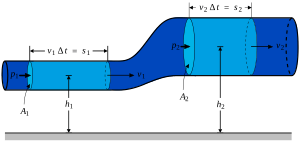Elasticity (physics) facts for kids
| Mechanics | ||||||||||

|
||||||||||
Elasticity is a cool property that some materials have. It means they can be stretched, squished, or twisted, and then they bounce right back to their original shape when you let go. Think of a rubber band or a spring!
This idea helps us understand how different materials behave when forces act on them. It's super important in engineering and physics.
Contents
What is Elasticity?
Elasticity describes how well a material can return to its first shape after being changed. Imagine pulling on a rubber band. It gets longer, right? When you release it, it snaps back to its original size. That's elasticity in action!
Not all materials are elastic. A piece of clay, for example, will stay squished if you press on it. It doesn't bounce back.
How Materials Stretch and Return
When you apply a force to an elastic object, its shape changes. This change is called deformation. The material stores energy while it's deformed, like a spring being compressed. When the force is removed, this stored energy helps the material return to its original shape.
If you pull or push too hard, the material might break or stay deformed forever. This is called reaching its elastic limit. Beyond this limit, the material won't fully return to its original shape.
Understanding Stress and Strain
To talk about elasticity, scientists use two important terms:
- Stress: This is the amount of force applied to a material over a certain area. Imagine pushing down on a table with your hand. The force you apply divided by the area of your hand on the table is the stress. It's like how much "push" or "pull" a material feels.
- Strain: This measures how much a material deforms or changes shape because of the stress. It's usually expressed as a ratio of the change in length to the original length. For example, if a 10 cm rubber band stretches to 12 cm, the strain is 2 cm / 10 cm = 0.2. It tells you how much the material "stretches" or "squishes" compared to its original size.
The Elastic Modulus
The relationship between stress and strain is called the elastic modulus. It's a number that tells you how stiff or flexible a material is.
- A material with a high elastic modulus is very stiff. It takes a lot of force (stress) to make it change shape (strain). Think of steel.
- A material with a low elastic modulus is very flexible. It changes shape easily with less force. Think of rubber.
This concept helps engineers choose the right materials for buildings, bridges, and even sports equipment.
Who Discovered Elasticity?
The basic idea of elasticity was first described by a famous English scientist named Robert Hooke. In 1675, he came up with what is now known as Hooke's Law.
Hooke's Law states that for many materials, the amount of stretch or compression is directly proportional to the force applied. This means if you double the force, you double the stretch. This law is fundamental to understanding how springs and other elastic objects work.
See also
 In Spanish: Elasticidad (mecánica de sólidos) para niños
In Spanish: Elasticidad (mecánica de sólidos) para niños


